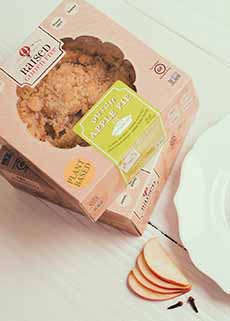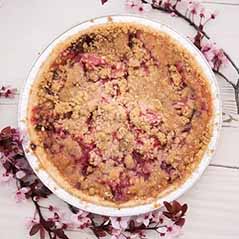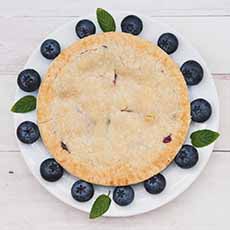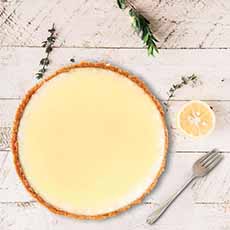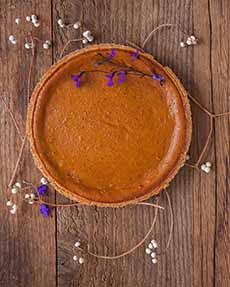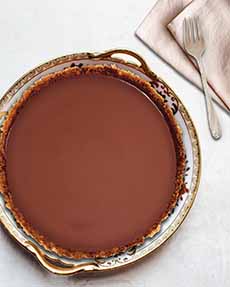Raised Gluten Free Pies & Quiche: Vegan & Nut-Free
|
|
Raised Gluten Free serves the growing demand for quality gluten-free baked goods with both sweet and savory pies. Made in small batches at a dedicated, certified gluten-free bakery in Northern California, the pies are not just gluten-free; they’re also vegan, nut-free, kosher pareve, and Non-GMO Project Verified. The business was founded by two friends, Rosa Dixon and Milia Lando, in 2011. Both had food allergies and became passionate about creating delicious treats for families with food restrictions. While there are more options in stores these days, back then finding tasty, gluten-free, nut-free, dairy-free, and egg-free products was a struggle. But today, Raised Gluten Free has a delicious complement of: The seven-ounce pies are sold frozen—easy to keep on hand for when your sweet tooth (or company) calls. Raised Gluten Free’s Apple Pie and Berry Peach Pie are sold at nearly all Whole Foods Market locations, plus at Fresh Thyme, Gelson’s, Kroger Stores, Market of Choice, Mom’s Organic Market, Nugget Markets, Safeway/Vons, and independent natural food stores across the country—a total of 3,500 locations. > Check out the company website for more information. As the box states, Raised Gluten Free pies are gluten-free, peanut-free, vegan, yummy delights in a category that rarely transcends any one of these restrictions. I was very curious if they would approach the elusive holy-grail of gluten-free baking and produce a tender, flaky pie crust so I tested both their Dutch Apple Pie and Strawberry Rhubarb varieties. — Georgi Page-Smith An apple pie is a perfect baseline with which to evaluate the competency of a baker and Raised’s Dutch Apple pie boded very well for the rest of their line. Bite after bite of this piquant pie delivered exceptional flavor, texture, and dimension. The apples were fresh and vibrant, their solidity and structure complementing the flakiness of the crust. Epic spices included a bold, rich cinnamon that tasted as if it had been ground the same morning, fresh off of a boat from Sri Lanka. The streusel provided variety, punctuating the apples at regular intervals with their playful crunch. My first small flake of the crust did not do it justice: It was delicious but fleeting. Small morsels of buttery flavored crust quickly intermingled with the filling, cobbler-style, eluding my grasp. It was a good substrate, but because there was not a lot of it, its star was somewhat dimmed by the hearty apples. While I certainly did scrape the sides of the tin for every last bit, I was left wanting more of this very good vegan crust. Crust aficionados: you may have to make do with a big scoop of ice cream to layer between delicious bites of apple. Food Trivia: The top layer is the main difference between a regular apple pie and a Dutch apple pie. Traditional apple pies have a top layer made from pie crust, while Dutch apple pies have a crumb topping. My much-anticipated sampling of Raised’s seasonal Strawberry Rhubarb pie also did not disappoint! This was a tart, jammy confection complimented perfectly by a scoop of ice cream. This is the pie to buy if you are a rhubarb fan, a strawberry fan, and/or a streusel fan; the three together were an engrossing dessert experience that commanded my full attention with their assertive textures and flavors. This is not a mass-produced pie that has had all of the flavor engineered out of it; it is a home-style, handcrafted pie that commits to a definite point of view. If most desserts are a party in your mouth, Raised Gluten Free pies would be a square dance! All in all, Raised pies manage a very difficult feat: a gluten-free dessert pie with a rambunctious homemade flavor and texture—and a delicious crunchy crust! The pies heat well and pair magnificently with ice cream or your favorite dairy-free equivalent. Food Trivia: While rhubarb originated in China and wild strawberries originated in Europe and Asia, it took a while for them to get together. Rhubarb was first used medicinally, and it was not cultivated for food until 1750 in Germany. The strawberry was first cultivated in Europe in the 1300s and it, too, was used medicinally*. Strawberry rhubarb pie appeared in Germany and the U.K. in the 1700s. |
|
|
________________ * The ancient Romans were staunch believers in the curative powers of the strawberry. They believed it relieved melancholy and masked bad breath. According to the ancients, strawberries could cure inflammations, fevers, throat infections, kidney stones, gout, fainting spells, and diseases of the blood, liver, and spleen. By the time the strawberry was cultivated in France in the 13th century, medicine was also a key use. The roots, leaves, and fruits of the Alpine Strawberry, Fragaria vesca, were used as a digestive aid and skin tonic. The strawberry was also prescribed for diarrhea and digestive upset, while the leaves and roots were used to relieve gout [source]. CHECK OUT WHAT’S HAPPENING ON OUR HOME PAGE, THENIBBLE.COM. |
||
